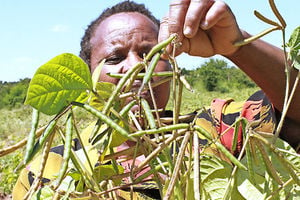
The share of credit going to the agricultural sector remains a mirage.
Despite frequent promises to develop the agricultural sector and promote farmers’ interests in Africa, the share of credit going to that sector remains a mirage, mostly owing to factors outside of it.
For one, lenders have found it profitable to focus on other areas, and authorities across the continent have been tinkering with interest rate controls without success, making it expensive for farmers to borrow.
Whereas some commercial banks maintain agricultural credit portfolios, twisted allocation of funds available for farmers somehow translates into the diversion of monies to other competing areas at the expense of agricultural activities, sources say.
Although the introduction of interest rate control talks often promises lower lending rates, widening spreads noticed between official interest rates implemented in Kenya during 2016 and actual lending rates charged in the agricultural sector triggered higher credit costs in this sector on account of heavy default risks associated with farming businesses.
Faced with a combination of limited government funding and severe climate change consequences, the share of agricultural credit weighed against local credit portfolios has averaged less than 20 percent in various African economies since 2015, data shows.
“There is an issue of banks lending to the agricultural sector, but filing their returns differently,” said Kwesi Korboe, an agricultural finance specialist based in Ghana.
“For example, in Ghana, a bank may lend money to Unilever (a local producer) for tomato processing activity but the loan is classified as a manufacturing sector credit facility.
“Banks also have problems with assessing project finance dynamics, including input elements for farmers such as the number of seeds, fertiliser, and tools needed in the field,” Korboe told an audience at the African Rural and Agricultural Credit Association (AFRACA) forum held in Kampala last week.
The overall credit portfolio accumulated by Ghana’s banking industry stood at Ghanaian Cedis 77.1 billion ($4.9 billion) by the end of December 2023 while total loan disbursements made to the agricultural sector amounted to Ghanaian Cedis 3.02 billion ($193 million), a figure equivalent to a 3.2 percent share of the industry loan book according to data published by ARD Apex Bank of Ghana Limited.
But Ghana is not unique. In Kenya, high interest rates coupled with risky business of lending to weather-dependent farmers mean it is not cheap to borrow to farm. Kenya began interest rate controls in 2016 but has since tinkered with the policy to allow banks a free hand that relies on what the Central Bank of Kenya lends.
“Although the interest rate caps were fairly low at that time, spreads between those caps and real lending rates applied on agricultural sector loans became wider because of high credit risks linked to the farming sector,” observed Dr Peter Wamalwa, a Central Bank of Kenya Official, speaking at the forum.
“This rendered agricultural loans more expensive while few farmers benefitted from agricultural credit. As a result, the share of agricultural credit has dropped to less than four percent today.
Agricultural sector loans issued by Uganda’s credit providers were valued at $262 million between 2016 and 2021, an outcome mainly driven by the growing uptake of agricultural insurance policy covers among local farmers. The total value of agricultural sector loans stood at $526 million between 2021 and 2023, data compiled by the local agricultural insurance consortium shows.
Yet there are problems. In Uganda, officials complain of poor documentation by farmers, even when the lenders may be willing to give loans. That raises risk of lending, or just discourages lenders from sending money to dark alleys.
“You sometimes find huge groups of farmers with 500 members but some of them carry fake documents and this forces you to realise how important public awareness is about financial products, including insurance policies,” explained Audrey Nsiyona, an executive at Uganda’s Agricultural Insurance Consortium Secretariat.
“Commercial banks, however, possess more administrative support in tackling such issues compared to us.”
In Burundi, the share of agricultural credit facilities in grew from two percent in 2019 to 16 percent in the first six months of 2024. Local credit institutions there provide loans to the farming sector at a maximum interest rate of eight percent per year while the maximum loan duration is five years, according to data compiled by Burundi’s Central Bank.
In comparison, Malawi’s agricultural sector has accumulated a credit allocation share of 16-18 percent in the local financial sector. This in turn has stimulated a 24.3 percent agricultural sector contribution towards the country’s Gross Domestic Product (GDP), according to data published by Malawi’s Central Bank.
The share of agricultural credit in Tanzania’s financial sector stood at 11.8 percent by the close of June 2024 while the sector’s loan default ratio was estimated at 5.6 percent during the same period. Interest rates levied by Tanzania’s Agricultural Credit Bank currently lie in the range of 15-18 percent per year, data released by the Bank of Tanzania shows.
“When agricultural loans go bad, participating financial institutions that have signed up to the Agricultural Credit Facility are required to make 100 percent credit default provisions for those loans,” noted Martin Magezi, a Bank of Uganda (BOU) Official.
“This discourages many banks from participation in the agricultural credit facility and there is need for an internal review to address this challenge.”






